

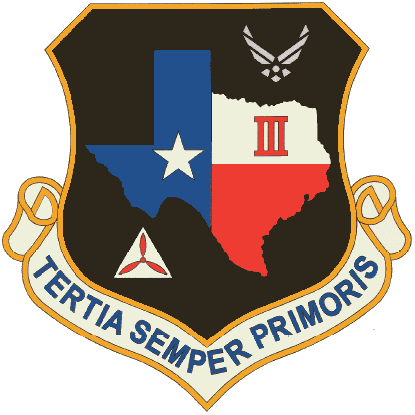 Heraldic Blazon
Heraldic Blazon
On a shield sable with a diminutive border or, the Texas state flag in the outline of the state of Texas proper, with a Roman numeral III gules in the field argent. On upper sinister quadrant, the Air Force emblem argent, on lower dexter quadrant a triangle argent with a three-bladed propeller gules. Motto: TERTIA SEMPER PRIMORIS (Third [Group] Always First).
Significance of the Emblem
The focal point of the emblem is the State of Texas which acknowledges Group III as a part of the Texas Wing and that our volunteers support the great State of Texas. As with the flag of the United States, the blue stands for loyalty, the white represents purity, and the red is for bravery, all traits exhibited by our volunteer members on a regular basis. The five points of the Lone Star represent the characteristics of a good citizen, which are fortitude, loyalty, righteousness, prudence, and broadmindedness. The Roman numeral three is the official Group designation and is positioned in North Texas near the location of the Group headquarters.
Within the black background are the symbols of the United States Air Force and the Civil Air Patrol showing the partnership that exists both by congressional order and by virtue of the great working relationship that we enjoy. The black background represents the night sky that our volunteers often work within providing support. The entire patch is surrounded in gold representing the purity of our intent to serve our fellow man through volunteerism. Finally, the motto "Tertia Semper Primoris" is Latin and translates to "Third Always First". This motto puts forth the Group III ideal to always strive for excellence in all that we do. Being first is not intended to denote winning but rather to lead the way.
The emblem design was co-authored by First Lieutenant Charles E Corway and Captain Arthur E Woodgate. The finishing touches were the result of a collaborative effort by a Group III team.
Information provided by:
Capt Charles E (Chuck) Corway
February 2007

Unit Emblem Heraldry
 The design of the George H. W. Bush Composite Squadron emblem was inspired by the symbols taken from the life of service of the former president.
The design of the George H. W. Bush Composite Squadron emblem was inspired by the symbols taken from the life of service of the former president.
The dominant device, the eagle grasping the olive branch and bundle of arrows, is borrowed from the seal of the President of the United States of America. Above it is the emblem of the Civil Air Patrol, the red three-blade propeller upon a white triangle upon a blue circle, here implied by a ring of stars. The stars number thirteen (twelve plus one) as a reminder of the anniversary of the Civil Air Patrol which was founded December 1, 1941.
The shield upon the eagle’s breast has a field of dark blue with three white vertical stripes, the center white stripe with a narrower red stripe upon it. This recalls the ribbon of the Distinguished Flying Cross, awarded to Former President Bush for his heroism on September 2, 1944.
Across the middle of the shield is blue bar edged in gold, which suggests the ribbon of the Air Medal, another recognition he received during his military service. Upon this are three gold compass stars, emblematic of the three times he was awarded this citation as well as the three elected positions he honorably held during his career in public service: as a Congressman from [the great state of] Texas, Vice President under Ronald Reagan, and of course as President of the United States of America. The compass star is taken from the design of the Air Medal itself, encircling an eagle carrying two lightning bolts, and it also echoes the primary device in the emblem of the Central Intelligence Agency, of which the former president was the eleventh director.
Within the eagle’s beak is a ribbon - on the emblem it is below so as to be legible - bearing a motto inspired by one of the former president’s own statements, "Any definition of a successful life must include serving others." Here it is expressed as "To Serve Others Is to Serve the Country" rendered in Latin ("Inservare alliorum est inservare patrium").
The George H. W. Bush Composite Squadron emblem was designed by Jacob Haldeman, a graphic designer and heraldry expert who graciously donated his time and expertise to produce the high-quality emblem befitting of the squadron’s namesake.
Information provided by:
George H. W. Bush Composite Squadron

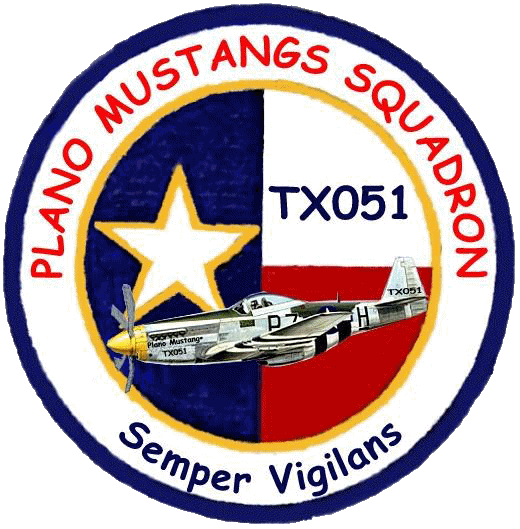
Information provided by:
Plano Mustangs Composite Squadron

The patch was designed by the squadron commander, Captan Robert "Skip" Smith, authorized the Winter of 2007-08, and maufactured in the Spring/Summer of 2008.
Information provided by:
Tyler Composite Squadron
(via James Wilson) March 2010

TX-089 is a composite squadron of the Civil Air Patrol located in Gregg County Texas. Civil Air Patrol's three missions are aerospace education, cadet programs, and emergency services, and the patch includes symbology reflecting leadership in each of these missions.
The crossed officer swords represent leadership in the cadet program, a program dedicated to training 12-18 year olds to be tomorrow's leaders.
The flight of aircraft represent leadership in aerospace education, a program dedicated to informing and exciting youth and adults about aerospace.
The T, X, W, G, represent the wing this squadron belongs to (Texas Wing) and with the center aircraft form a compass representing leadership in emergency services, a program dedicated to performing disaster relief, search and rescue, and many other services at a local and national level.
This patch was created in June of 2015 by the members of the squadron.

131st Johnson County Composite Squadron re-introduced the "Texas Acas" squadron patch around 2009 after a long absence and after uncovering draft designs by its designer.
Three ink drawings of the former 131 Air Search and Rescue Composite Squadron patch were created by former commander Major John A. Seay, Jr, serving from 1986 to 1990. The drawings, three in all, created
around 1986 reveal the progression of the patch design, a USAF shaped shield with clear, simple symbols of a spade, wings, star and nickname "Texas Aces" and motto "Dedicated and Determined".
Seay, a crop applicator (crop duster) and country western musician who had a flare for promotion and an artistic eye, created the patch and changed the unit's name to the 131 Air Search and Rescue Composite
Squadron, formerly the Cleburne Composite Squadron, on 25 Nov 1958 to reflect its history, past, present and future.
The unit participated in air search and rescue missions including a search for a missing USAF F-111 fighterbomber.
Years later TX-131 was designated as a flight around 2003, then re-instated as a squadron under the name 131st Johnson County Composite Squadron in 2007.
Though the squadron has changed names and designations over the years, the unit has been in continuous operation under its own management celebrating its 50th birthday in 2008, looking forward to its 60th year and
beyond, honoring all "Texas Acas" past, present, and future.

The current patch is the only known one. As an active member in the area for many years and a previous squadron commander from the 1970s, Lt Col John Samuel said that he did not remember the unit ever having a patch. The general layout and color scheme are as currently required for U.S. Air Force (AF) unit patches below the group level: circular patch, upper arc with unit name, optional lower arc with motto, yellow borders, red, white, and blue main colors. While adherence to AF Instruction 84-105, Ch3 (1 March 98) was not mandatory for Civil Air Patrol (CAP) units, the Texas Wing commander at the lime, Col R F Eidridge, wanted his units to follow it as a guideline. Lt Col Dietrich P Whisennand, the acting commander of the squadron for the year while it was awaiting official re-chartering, conceived and drew the design, and Capt Felipe Gomez, a professional graphic artist and member of the unit, did the cleanup and digitization of the final design.
The left field of blue contains the CAP trademark red three-bladed propeller within the white triangle which is one of the current three required elements for a CAP patch of any type (the other options are the full name or initials of CAP).
The right field of red with the circular 5-star insignia is in honor of General of the Army Douglas MacArthur, the namesake of MacArthur High School in Irving, TX. The unit has met there since its inception, most of the initial re-chartering members were involved there as students, family, or staff, and the commander of the unit since its re-chartering, Lt Col Cynthia S Whisennand, serves as a librarian at the school. The design is from the proper Army of office for a General of the Army.
The central divider between the fields is the NASA orbiter under power, alluding to the Aerospace Education mission of CAP as well as the fact that many of the initial re-chartering members served in the Task Force
Columbia disaster relief mission shortly before the unit began the re-chartering process.
The motto, 'Conor Ut Perficio', translated as 'Strive To Achieve' was suggested by Cadet 2nd Lt Rebecca Walther, one of the initial re-chartering new members and the MacArthur student most responsible for recruiting the majority of the first cadets and several senior members as well.

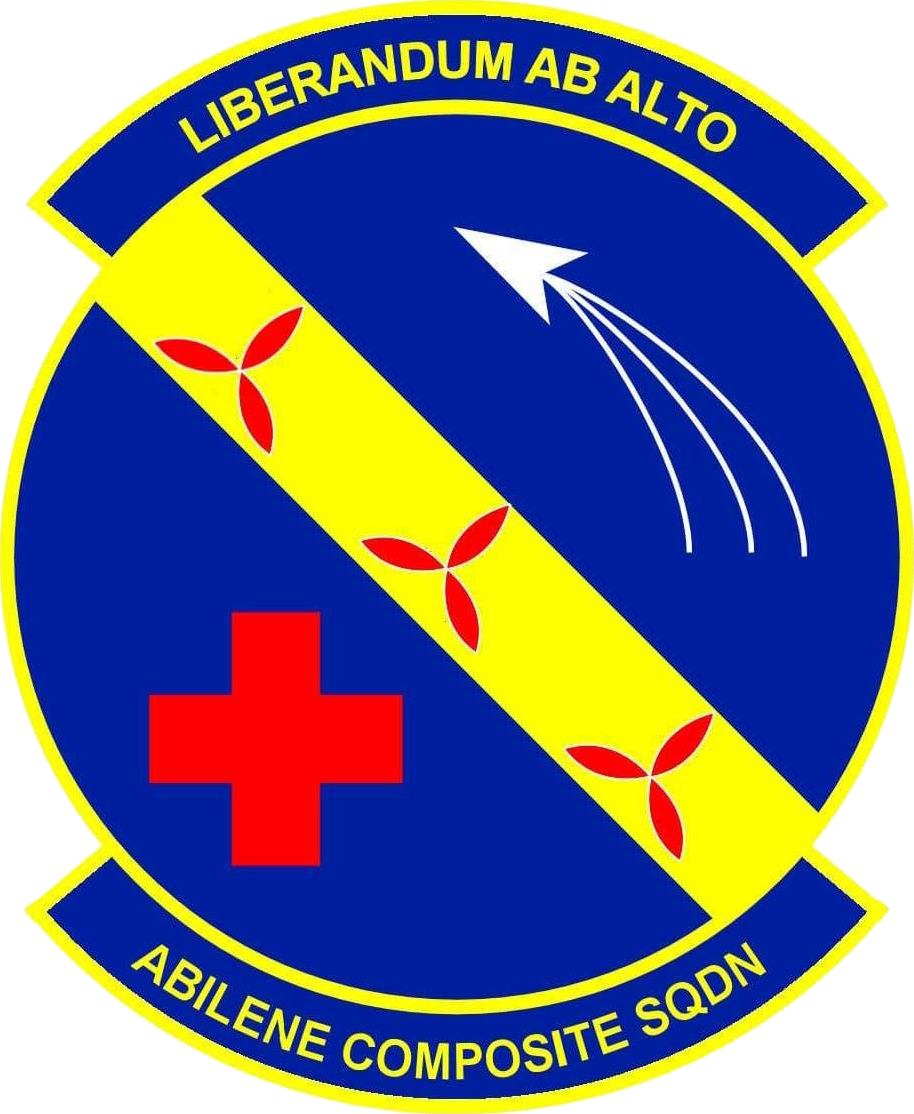 The Emblem of Abilene Composite Squadron is a disc of Ultramarine Blue, with a band of gold transitioning from dexter chief to sinister base emblazoned with a trio of three-bladed propellers. There is a futuristic aircraft located at the sinister chief and a red cross at the dexter base. In the bottom scroll is our squadron designation "ABILENE COMPOSITE SQDN" and in the upper scroll is our motto "LIBERANDUM AB ALTO," meaning rescue from above.
The Emblem of Abilene Composite Squadron is a disc of Ultramarine Blue, with a band of gold transitioning from dexter chief to sinister base emblazoned with a trio of three-bladed propellers. There is a futuristic aircraft located at the sinister chief and a red cross at the dexter base. In the bottom scroll is our squadron designation "ABILENE COMPOSITE SQDN" and in the upper scroll is our motto "LIBERANDUM AB ALTO," meaning rescue from above.
The blue background, being symbolic of our loyalty to the history and tradition of Civil Air Patrol, is symbolic of where we perform most of our missions. The yellow trim and band are symbolic of the excellence we pursue in executing our duties and reminds us to keep true to our three missions.
The red of the cross represents our passion for service to our nation while representing the emergency services missions so vital to life. The three red props across the band represent our patriotic spirit and devotion to Community, State, and Nation, while the three-bladed propeller reminds us of the missions we are charged to perform: Aerospace Education, Cadet Programs, and Emergency Services.
The white of the futuristic aircraft is symbolic of our benevolent mission to the country through the use of aerospace and the three tails remind us to remember the past, present, and future of the organization while performing our duties.
The patch in whole reflects our close relationship with the 7th Bomb Wing, Dyess AFB, Texas, with whom we share community, the skies, and whose professionalism, readiness, and commitment we wish to embody.
The emblem was designed by Lt Col Jed Taylor and authorized September 30, 2018.
Information provided by:
FO Laureen Blackwelder, CAP
Public Affairs Officer, Abilene Comp Sq
February 24, 2019

Creation of a new squadron patch began in December 2015, a project headed by Major Lee R Tallier III in coordination with graphic artists of patch manufacturer Vanguard Industries. The direction first went toward modifying the current patch (Version 2c) by changing the upper scrool from "PEGASUS" to a new motto and replacing "SEARCH & RESCUE" in the bottom scroll to the unit's full name. Captain Johnathan Foster, Texas Wing's Interim Heraldry Officer, reviewed the concept (below, left) and requested the scrolls be of equal width. He also noted that while not required, it had been common practice for other units within the wing to include their [charter] number. Major Tallier later submitted a shield concept (below, center) for Captain Foster to review, but was unsure whether it was appropriate. Captain Foster then proposed a third concept (below, right) in an "acceptable format" which he made by combining the previous two concepts.



With the blessing of the Pegasus Composite Squadron commander, 1st Lieutenant Rick Mierow, the third concept was submitted to Texas Wing Headquarters for approval accompanied by the following description:
"Two facing pegasi representing senior members and cadets (as we are a composite squadron) standing guard over the State of Texas and its people. The sable background represents both the infinite possibilites that await us and the knowledge that we contnually seek. The gold color represents that all of CAP is made up from volunteers (generosity and service above self). The motto of Acta Non Verba - actons not words, states our belief that what we do represents us far greater than what we say."
The patch's design was approved by the Texas Wing Commnader, Colonel Sean Crandall in April 2016. Vanguard provided multiple stitched-out proofs of the design where there was concern over the state map's shape and the clarity of the "TX-351" within it, leading to the final production being slightly altered from the approved design.
Information provided by:
Lt Col Dennis A Eibe, CAP
Commander, Pegasus Comp Sq
September 30, 2025

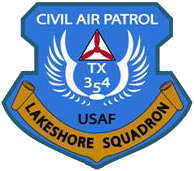 The blue background with green border represents our home; Lake Ray Hubbard, and on its green shores, the city of Rockwall.
The blue background with green border represents our home; Lake Ray Hubbard, and on its green shores, the city of Rockwall.
At top, Civil Air Patrol; our name and our missions are always 'tops' in our minds and hearts.
The three-bladed prop symbolizes our 3 primary missions:
Cadet Programs, Aerospace Education, Search & Rescue -- all vital 'Missions for America'.
TX 354 proudly identifies our unit, part of the great State of Texas and the Texas Wing of C.A.P.
The Wings of Silver symbolize the sterling qualities to which we aspire, and which we hope to pass to our youth through the Cadet Program; helping today's youth become tomorrow's leaders. These include service before self & a love of God and Country. They also remind us of the clouds through which we fly (though not all have a silver lining) and our passion for flight.
At the base of the wings is a small Arrowhead, symbolic of our historic role in the defense of our Country; and our willingness to bear arms again if we are called to serve. It also calls to mind our Native American ancestors, who once lived and hunted on this lakeshore, and began the process of settling the area.
The letters USAF remind us of our mentor & partner in continuing the valuable role that C.A.P. plays in service to America, both as a volunteer non-profit organization and as the official auxiliary of the U.S. Air Force.
Lastly, Lakeshore Squadron on a Banner of Gold identifies the unit we proudly represent, and the "Golden Rule;" to treat others as we would be treated, with Honesty, Integrity and Respect.
In December 1975, Unit 42354 was chartered as Raider Cadet Squadron at Skyline High School in Mesquite Texas -- in support of their active Aviation Program; teaching A&P mechanics and other aviation careers. It was led by John R Brown, the head of that program and the squadron's first commander.
In 1983, the program left the school and became Skyhawk Composite Squadron; Ross Riegling was commander.
In 1984, the name was changed to Garland Falcon Composite Squadron under the command of 1st Lt E. Hugh Heck III, who in November 1985 moved it to its current location at Rockwall's Ralph M Hall Airport and gave it its final name change; to Lakeshore Composite Squadron.
The patch was designed in 1998 by Lakeshore Squadron members Mary Adams, Steven Adams, Matthew Barnes, Robert Barnes, Kevin Bauder, Michelle Blahut, Gary Blair, Brandon Blair, Clint Boldt, Peter Boronkay, Richard E Brown Jr, Charles Ellis III, James Groom, Cody Jensen, Justin McClellan, Sean Mellott, Jarrett Pittsinger, Barbara Robertson, Kyle Rogers, Michael Rothman, Robert Rothman, Jamie Rupar, Shawn Stelzel, Isaac Whitt, Robert Wieneke, Stephen Wisdom and Andrew Yates.
Information provided by:
Maj Robert Wieneke, CAP
Commander (1999-2004), Lakeshore Comp Sq
February 2021

The squadron was activated in 1973 and was first called the Talon Composite Squadron and met in Midlothian, Texas. It was deactivated and then reactivated in 1988 when Major Smalley, myself [???] and several other seniors met in Waxahachie. In 1991 it was deactivated again because the supercolider was shut down. Another squadron,TX-443, was begun at the Midway airport and then moved to the Lancaster Airport and is known as the Jolly-Green Composite Squadron. Jane Smalley and I decided we wanted to reactivate the Talon Squadron in 2003 and the TX-376 was again activated and re-chartered as the Waxahachie Talon Composite Squadron.
 We kept the Talon part from the original charter and instead of the Talon trainer aircraft onthe original patch, we went with the "talon" of the birds of prey - many of them in the Waxahachie area. The two flags represent our Texas and American loyalty. The Latin phrase "Neutiquam Erro" literally means "I Am Not Lost" but it was the closest we could get to "I Know The Way". This is a reference to the ground team training we do at our squadron.
We kept the Talon part from the original charter and instead of the Talon trainer aircraft onthe original patch, we went with the "talon" of the birds of prey - many of them in the Waxahachie area. The two flags represent our Texas and American loyalty. The Latin phrase "Neutiquam Erro" literally means "I Am Not Lost" but it was the closest we could get to "I Know The Way". This is a reference to the ground team training we do at our squadron.
Information provided by:
Gerrald Phillips

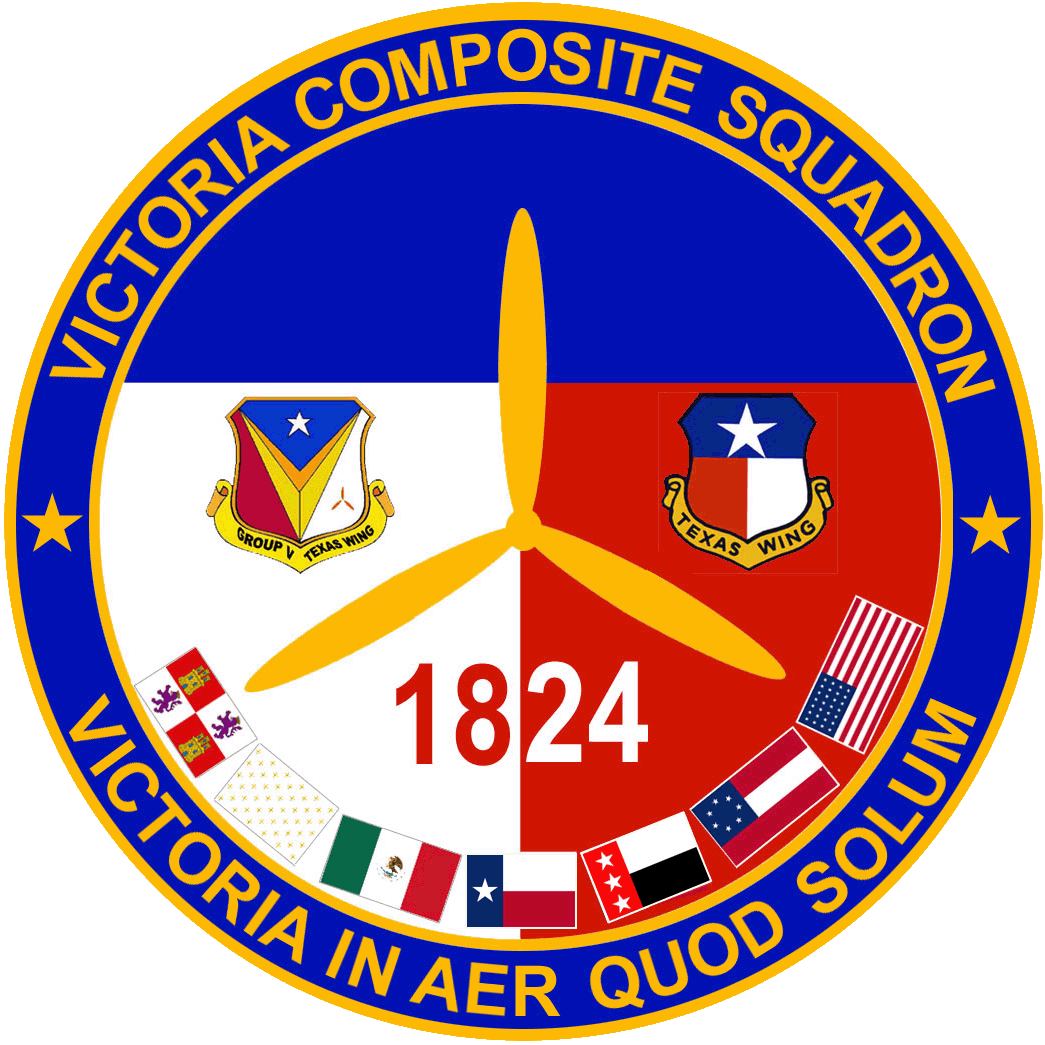 The heraldic blazon (the unique language used to describe heraldic emblems) is as follows:
The heraldic blazon (the unique language used to describe heraldic emblems) is as follows:
On a field chief azure, lower per pale argent and gules in the colors of the Texas flag, with diminutive border or, on fess point a 3-bladed propeller or. Sinister, the Command Shield of Texas Wing in colors proper, and dexter the shield of Group V in colors proper. Base fess point the date 1824 in contrasting colors argent and gules. In lower base semi-circle, the flags of Kingdom of Spain, Kingdom of France, Republic of Mexico, Republic of Texas, Republic of the Rio Grande, Confederate States of America, and United States of America, in colors proper, in the version that first flew over the City of Victoria. Full orle azure with diminutive border or, estoile or sinister and dexter, with the words VICTORIA COMPOSITE SQUADRON chief, and the motto VICTORIA IN AER QUOD SOLUM base, letters or.
In plain English, the above means:
On a disc with a thin gold border, the shield is partitioned on the top third in blue, and the bottom two thirds partitioned vertically in white and red, the colors of the Texas State Flag [in proper order of display on a wall]. Centered on the shield, a 3-bladed propeller in gold. On the red partition, cradled by the propeller, the Command Shield of Texas Wing, and on the white partition, cradled by the propeller, the shield of Group V. Centered under the propeller, the year 1824 (when the City of Victoria was chartered) in contrasting colors. At the bottom of the shield, arranged peripherally, the flags that have flown over the City of Victoria: Kingdom of Spain (1519-1685 and 1690-1821), Kingdom of France (1885-1690), Republic of Mexico (1821-1836), Republic of Texas (1836-1845), Republic of the Rio Grande (briefly in 1840, when Victoria was its provisional capital), Confederate States of America (1861-1865), and United States of America (1865-present), each one depicted in the version first flown over the City of Victoria. Surrounding the shield, there is a wide band in the same blue as the canton of the Texas Flag, with a thin gold border. Inside the band, around the top, the words VICTORIA COMPOSITE SQUADRON, and written at the bottom the motto VICTORIA IN AER QUOD SOLUM (Victory in the Air as in the Ground) all in gold. The squadron’s name and the motto are separated by two gold stars left and right.
The symbolic meaning of the elements is as follows:
On a disc with a thin gold border (symbolizing generosity and elevation of the mind), the shield is partitioned on the top third in blue (truth and loyalty), and the bottom two thirds partitioned vertically in white (peace and sincerity) and red (courage, strength and magnanimity), the colors of the Texas State Flag, shown in proper order of display on a wall. Centered on the shield, a 3-bladed propeller in gold, an essential element of the planes CAP flies. On the red partition, cradled by the propeller, the Command Shield of Texas Wing (the state's major command), and on the white partition, cradled by the propeller, the shield of Group V (the intermediate command). Centered under the propeller, the year 1824 (when the City of Victoria was chartered) in contrasting colors. At the bottom of the shield, arranged peripherally, the flags that have flown over the City of Victoria: Kingdom of Spain (1519-1685 and 1690-1821), Kingdom of France (1885-1690), Republic of Mexico (1821-1836), Republic of Texas (1836-1845), Republic of the Rio Grande (briefly in 1840, when Victoria was its provisional capital), Confederate States of America (1861-1865), and United States of America (1865-present), each one depicted in the version first flown over the City of Victoria. Surrounding the shield, there is a wide band in the same blue as the canton of the Texas Flag, with a thin gold border. Inside the band, around the top, the words VICTORIA COMPOSITE SQUADRON, and written at the bottom the motto VICTORIA IN AER QUOD SOLUM (Victory in the Air as in the Ground) all in gold. The squadron’s name and the motto are separated by two gold stars [left and right], denoting that the City of Victoria is the second oldest chartered population center in Texas.
The unit emblem was designed by Capt. Arthur E. Woodgate, Director of Public Affairs, Southwest Region.

The patch of Nighthawk Composite Squadron dates back to 1997 when the squadron was known as Denton Fighter Composite Squadron. In the mid-1990s the squadron, as many others have, experienced a severe low point: the squadron had dwindled down to less than seven total members. In an effort to revitalize the squadron, an intensive membership drive brought in dozens of new members - both senior members and cadets. The new members worked to bring a new face to the unit.
The senior members charged the cadets to choose a new name for the squadron and design the first squadron patch. The cadets chose to rename Denton Fighter Composite Squadron after the most advanced fighter of that time, the F-117 Nighthawk. The cadets then, as a whole, developed Nighthawk Composite Squadron's first patch.
As a squadron patch, the disk shape was chosen. As Nighthawk CS was becoming an emergency services focused unit, the cadets chose to focus the symbolism of the patch on the emergency services mission. The background colors of blue and green symbolize the ES operations in the air and on the ground. The state of Texas with the Texas flag identifies the home of the squadron, as does the silhouette of the airplane flying over North Central Texas.
The eagle has multiple meanings: the eagle represents our nation and CAP's role as a national organization, the eagle supporting the state of Texas represents our duty of serving our home, and the wings spread surrounding the state is reminiscent of the emblem of the Air Force Rescue services with an angel's wings surrounding the globe.
The new squadron's motto "EYES OVER TEXAS" is embroidered across the top of the disc over the state, and the squadron's primary mission "EMERGENCY SERVICES" is embroidered across the bottom of the disc over the eagle. The squadron's new name "NIGHTHAWK" is embroidered across the top rocker of the disc, and the squadron's charter number "TX413" is embroidered across the bottom rocker of the disc.
Information provided by:
Captain Seth Hudson, Nighthawk Comp Sq

The design for the Rio del Fierro Composite Squadron patch is derived from an old American Indian story of a meteor that had fallen to earth some time ago and shattered near the Red River, spreading some kind of metal along its shores. Rio del Fierro means, in Spanish, "River of Iron".
The Texas flag used for the background represents the "Lone Star" state and the CAP wing this unit is affiliated. The map of Texas with the smaller state flag within represents the beginning of the squadron's charter number (TX) with the 430 at the top being the squadron's numeral itself. A star placed at the appropriate location of Wichita Falls and Sheppard AFB; the location of the squadron's headquarters. And its affiliation; a gray river [of iron] flowing from the star and through the border signifies the squadron name and our members' "iron strong" loyalty, will and dedication to mission. The Cessna 172 pictured in
the upper right represents the airplane (N99245) assigned to the unit shortly after it was organized and chartered in 1992. All this in the colors of the Great State of Texas and placed on an Air Force shield to honor the parent organization that is the United States Air Force.
The patch was designed by Captain Jack V Koby and authorized for use by Texas Wing on August 1, 1998.

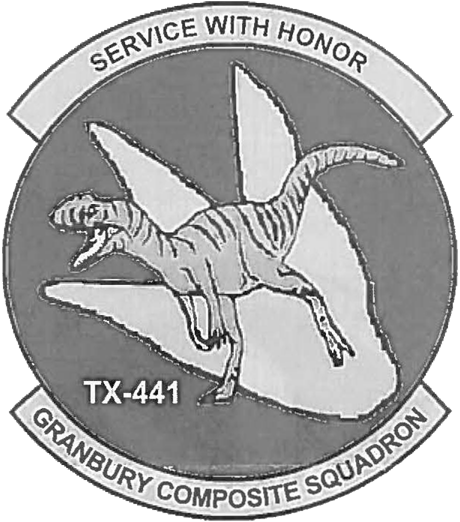 THE HERALDRY OF THE PATCH
THE HERALDRY OF THE PATCH
THE COLORS:
ULTRAMARINE BLUE, for the sky and our mission in Aerospace Education
AIR FORCE YELLOW, symbolizing our tie as the USAF auxiliary, Our Core Values, and Honor
SAFETY ORANGE, to represent our mission in Emergency Services, Confidence in our abilities and our comrades, and Endurance
BLACK, for the dedication of our volunteer professionals
THE SYMBOLS:
A THEROPOD TRACK, representing our locality near Dinosaur Valley State Park
AN ACTIVE, FORWARD-LOOKING THEROPOD, representing the power of the Cadet Program, the drive and resourcefulness of our cadets, and our squadron's victory over extinction:
WE'RE ALIVE AND RUNNING, FULL SPEED
THE TX-441 MOTTO:
SERVICE WITH HONOR

Design, Approval & Manufacturing Process

 May 3, 2022
May 3, 2022
Squadron members voted on submitted emblem designs.
May 10, 2022
Selected emblem design presented to squadron members;
submitted to Wing Heraldry Department for review.
December 19, 2022
Feedback received from Wing/National Heraldry Department with suggested changes.
February 7, 2023
Modified design presented to squadron members.
March 20, 2023
Modified design resubmitted to National Heraldry Department for review.
May 29, 2023
Design deemed acceptable by National Heraldry Department;
Emblem Proposal Package submitted through chain of command.
June 13, 2023
Emblem authroized by Colonel Martha Morris, Southwest Region Commander.
August 25, 2023
Embroidered patch proof received and a revision is required.
September 1, 2023
Second embroidered patch proof received and approved.
September 23, 2023
Received the wrong patches from the manufacturer from an unrelated order.
October 14, 2023
Recevied the correct patches from the manufacturer.
Information provided by:
Captain Eric Pearson, Commander
March 12, 2024

On or about December 2011, a visitor from Azle High School in Azle, TX attended a meeting at Phoenix Composite Squadron and was wondering if there was a squadron close to Azle. They had wanted to join a ROTC unit and said that the high school had inquired about obtaining a ROTC group at the high school but were told that due to the budget cutbacks in all of the military services, no more ROTC units were being established. This visitor had heard about CAP and had discussed it with one of the high school teachers, Mr Bill Wyser. Mr Wyser is a retired Marine fighter pilot and he also came to a Phoenix Squadron meeting to see if a CAP squadron could be started at the high school. After a couple of meetings, Mr Wyser was told that "Hornet Flight" could be established at Azle High School. Hornet Flight was selected as the name because "Buzzy" the hornet is the Azle High School mascot. Mr Wyser spoke to the Principal at the high school and he received enthusiastic support from the Principal. Paperwork was submitted to TX Wing and Hornet Flight came into existence with Senior Member Bill Wyser as the Commander.
On 16 March 2012, application was made to TX Wing to Charter "Hornet Composite Squadron" as a new squadron within TX Wing. An objection was made to the use of the word "Hornet" as non-complying with the CAP regulations. On 28 June 2012, a second application was made requesting a Charter for "Azle Composite Squadron". This name was approved and notice to all members was sent out on 20 July 2012 that the Charter
had been approved. Membership in the squadron at that time consisted of 29 Cadets and 5 Senior Members.
In the intervening time between becoming a Flight and a Squadron, some of the members of the squadron attended the art class in the high school and the art teacher was approached about having the art students design a new patch for the squadron. This suggestion was accepted by the teacher and all of the students in the art class were asked to present a suggested design for the squadron patch and the winner of the
competition would be selected by the cadets in the flight. Numerous designs were submitted for selection and over several weeks, cadets selected a winning design. While a copy of the original art class design that was selected is not available, below are three transitional designs that ended up as the final patch.

Information provided by:
Chaplain Lt Col William R Twa, Jr
February 4, 2015